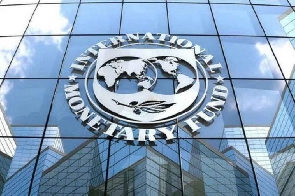A new dispute over Ghana’s macroeconomic performance foe 2020 and its standing into this year may be brewing as the International Monetary Fund, in its latest staff mission report on the country has computed the government’s fiscal deficit for last year at 15.5 percent of Gross Domestic Product, which is significantly higher than the 11.8 percent declared by the government itself. Although both sides agree on the causes of the variance they are no closer to resolving the differing stances underlying the causes.
In a similar vein, the Fund has computed Ghana’s end 2020 public debt to GDP ratio at 78.0 percent, also significantly higher than the 76.1 percent declared by government itself. The differences in computations are the results of differences in how the cost of financial sector reform and energy sector legacy debts have categorized a disagreement that has continued ever since government began debt financing the bailout of customer deposits held by various genres of financial intermediation companies in 2017. While government classifies them for some purposes as memoranda items rather than current fiscal items, the IMF insists on adding them to all macroeconomic performance and fiscal standing computations.
The results of the IMFR’s stance are captured in a part of the official statement from its most recent staff mission which reads : “Government interventions in 2020 also exacerbated pre-existing fiscal rigidities and public debt vulnerabilities. The government deficit, including energy and financial sector costs, reached 15.5 percent of GDP, while annual gross financing needs exceeded 20 percent of GDP. Public debt rose to 78 percent of GDP in 2020, from 64.4 percent in 2019, including ESLA of GHs7.63 billion in 2020.”
The Ministry of Finance has responded to the media’s coverage of the discrepancies through a press statement which effectively agrees that the variance is the result of the energy sector legacy debt. However, it defends its exclusion of that debt by arguing that its figures are based on its use of central government classification as different from the IMF’s use of general government classification which includes the debt of non-central debt institutions and agencies. In this case, the difference arises from the debt taken up by ESLA, the special purpose vehicle being used to defray the energy debt.
Government’s point is that ESLA is a registered corporate institution which is paying off the energy debt outside of the government’s usual finances and so the debt should not be part of the government’s balance sheet. But the IMF insists that the debt, just like ESLA itself is an extension of the state’s finances and so should be included in its financial position statements and computations. Says the statement from the Ministry of Finance:
Budget and Debt Classifications are based on international classifications known as central government or general government classification.
Governments all over the world report at least at the central government level – which means the activities that the central government is involved in for all Ministries, Departments and Agencies but excludes Local government, State-Owned Enterprises or other investment interests of Government, apart from debts guaranteed by central government.
When you add local governments and SOEs to the central government classification, then you are reporting on general government classification. Ghana, as a country, reports on central government budgeting and not general government budgeting.
Consequently, Ghana’s public debt stock is calculated as all the debt incurred by all Ministries, Departments and Agencies and any other debt that the Central Government guarantees for any Local Government or SOEs.
With this definition, the 2020 public debt stock as a percentage of GDP was 76.1%, up from 62.4% recorded in 2019. This corresponds at the same level to those from the IMF. In other words, the 2019 Public Debt Stock as percent of GDP was 62.4% and 64% for the MoF and IMF respectively. Similarly, the end 2020 Public Debt stock was 76.1% and 78% for the MoF and IMF respectively.
The IMF explained the variance indicated above by categorically stating in their press release that they included ESLA debt of GHS 7.63 billion which relates to the debt of energy SOEs and are therefore excluded from the central government classification used by the Government.
Therefore, IMF and government computation are not at cross purposes. We once again reiterate that the Ministry operates an open door policy and would therefore encourage the media to seek clarification of issues from us before publication.
To be sure government’s stance on this issue, although dubious from a technical point of view, is prudent in that lowering its debt position it supposedly gives it more fiscal space for further borrowing and at the same time is supposed to enable it to get more favourable borrowing terms than would otherwise be the case, both of which are to Ghana’s advantage.
The snag though is that the IMF has let the cat out of the bag; the international investment community will go with the IMF’s figures and the stand behind it rather than government’s and so those advantages will not accrue to it.
Furthermore, the government’s stance consequently understates its financing needs, with regards to the financial sector reform costs which it includes in the public debt but not in its fiscal deficit, even though its borrowings to pay for the reforms have to be financed. Curiously it does not refer at all to the cost of the financial sector reforms and its impact on the fiscal deficit in its statement on the discrepancies between its figures and those of the IMF.
Importantly the disagreement between the two is not affecting the good relations they have with each other and the IMF says it stands ready to offer government another Rapid Response Facility on top of the US$1billion it provided last year.
The International Monetary Fund (IMF) mission led by Carlo Sdralevich held consultations under Article IV during April 28 – May 12, 2021, through virtual meetings.
Based on its computations the staff mission asserted that “The 2021 budget’s recent policy pivot towards fiscal consolidation is an important step in the right direction and a difficult one in a pandemic. Fiscal consolidation should be deepened and anchored around debt and debt service reduction to create space for social, health, and development spending.
“Given the social and equity implications, fiscal consolidation should rely more on progressive revenue and spending measures, while guaranteeing fiscal support to the most vulnerable and social safety nets.
“Despite progress in rationalizing power generation, the financial viability of the energy sector affects people’s daily life and will remain a drag on productivity and a driver of public debt if not addressed decisively. Improving efficiency and collections remains a priority to achieve substantial savings. “
Despite its warnings, the IMF’s staff mission report on Ghana was generally upbeat, saying
“Ghana has managed very effectively the COVID-19 outbreak in the country, and thus succeeded in protecting lives. Almost 93,000 cases have been confirmed, and unfortunately, 780 people have died as of today. The launch of mass vaccine rollout has been a breakthrough, with the administration of approximately a million doses as of end-May.
“The impact of the pandemic on the economy has been severe. Real GDP growth slowed to 0.4 percent in 2020 from 6.5 percent in 2019, due to lower activity in the extractive industries and a collapse in hospitality and retail services, including the informal sector that especially employs female workers. Inflation spiked to double-digit because of food price pressures, before falling to 8.5 percent in April 2021.
“Policy interventions in 2020 were also critical to safeguard livelihoods and paved the way for a faster rebound of economic activity. Real GDP growth is projected at 4.8 percent in 2021, driven by a rebound in mining and services. Inflation is expected to remain around the central bank’s target of 8 percent by end-2021. The CARES program has the potential to be transformative and inclusive for the Ghanaian economy, buttressed by its emphasis on SMEs and digitalization as well as leveraging the AfCFTA.
However, another problem may be brewing for government as it prepares to accede to the IMF’s request for an audit of COVID-19 emergency spending and of arrears accumulated in 2020—in addition to routine budgetary reporting practices – which the Fund asserts will help account for last year’s extra-budgetary spending.
Some public policy analysts are already predicting that the exercise may expose some general election motivated extra-budgetary spending done by government to woo the electorate, under the cover of its COVID 19 instigated emergency spending mandate. However government has little choice in the matter as its accessing a US$1 billion Rapid Response Facility last year gives the IMF the right to demand for fiscal accountability. Indeed, this may deter government from accessing the new one that is becoming available.
The rash of unpopular new taxes and levies imposed in the 2021 budget are being explained as largely necessary to meet the cost of the COVID 19 amelioration expenditures made last year. But if then expenditure audit insisted on by the IMF reveals that a substantial part of that extra public expenditure was done for election-related reasons, government’s critics would have new fuel with which to fan the embers of political opposition to the new fiscal measures.
According to the official statement from the IMF staff mission, “the team had collaborative and constructive discussions with Vice President Bawumia, Finance Minister Ofori-Atta, Governor Addison of the Bank of Ghana, other senior government officials, Finance Committee of Parliament, private sector representatives, and civil society organizations.”
Source: goldstreetbusiness.com
 Home Of Ghana News Ghana News, Entertainment And More
Home Of Ghana News Ghana News, Entertainment And More






